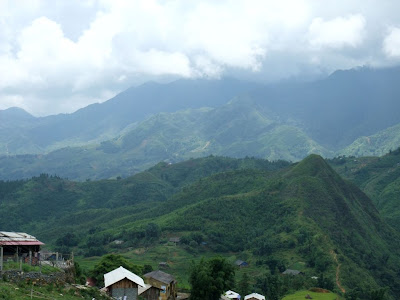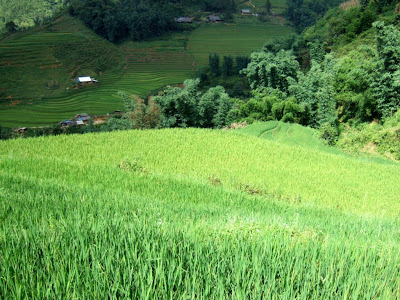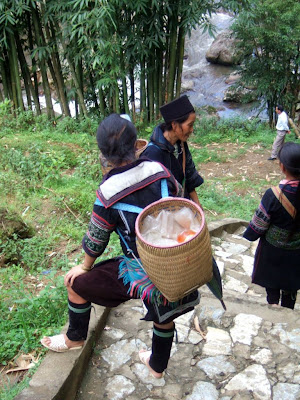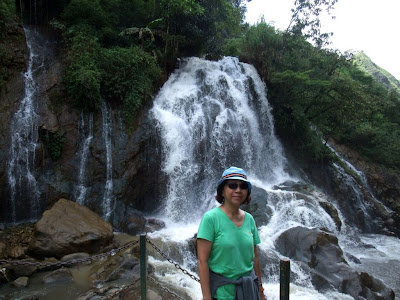
About 2km away from Sapa Town, there is an aged village of H'Mong ethnic group remaining customs and practices called CatCat Village. It takes about 45 minutes of walk from Sapa downtown to reach this hamlet. There are beautiful wild terrace fields, curling stone road and long standing culture of H'Mong ethnic minority people. It could be a hide-way destination for those living in noisy and animated cities to escape.


CatCat Village lies at the foot of Fanspian mountain ranges.



The village is amidst in a wild nature.



Majestic view of Fansipan Mountains



Fansipan Peak is always covered with cloud throughout the year, few people have luck to view its true look.










A school in the village but it's sad to learn that no many children are sent to school in this region. Many kids are busy in earning some income to help the family.


Some elegant colonial building structure at the foot of Fansipan mountains.



Queen of the mountains, it so called.








Climb up a watch tower through some stone stairs to have a panoramic view of the region.





Groups of tourists from all over the world, flock in to this picturesque site.


The young girl, my CatCat Village H'Mong guide is about 20 years old, married with a child . Though not too knowledgeable and not even can read or write a word, she can speak simple English.



H'Mong and Dzao ethnic people have obviously grasped the importance of speaking English as it can help to bring in more money. Young guys like them who can communicate in English have become village guides for foreign tourists.


A great view of the nearby region from this little old French Colonial style tower. My guide was not able to tell us clearly what was this old structure for in the past.



The beautiful reddish creepers and other little plants are growing over the whole area of the roofing.




You will meet with many H'mong people while walking via this route to CatCat Village. They are good nature people and very friendly to outsiders.




It's queer to encounter the scene like this especially in a village: A dog is chained but provided with pillow to sleep comfortably. I was also surprised to find that the American world famous brand The North Face are available here, in the shop that sell trekking and outdoor activities items. Authentic or fake, nobody cares.



A small town of CatCat Village.



The simple and primitive indicative signboard.


The small scheme rice field and its water milling pond are the first scene when stepping onto its curling stone pathway into the village.



Cute little local kids.




H'Mong girls and women.



The stalls along the curling stone pathway and plants grown as dying agent for their brocade.



A tradition house is covered with Pomu wood roof. The walls are made from saw timber. It normally has three rooms, three doors and three columns standing in a round or square stones inside the house. The central door will not be opened unless they have important events. .



Colorful pieces of brocade decorated with designs of flowers and birds. Each piece of brocade is dyed and embroidered with pretty patterns. They use plants and leaves to dye the brocade fabrics and polish them by rolling around the smooth section of a wood covered with wax to make the color durable.



The H'Mong people are mainly attached to traditional work in planting cotton trees, terrace rice fields, corn fields and weaving brocade cloth.


Natural water supply. Water running from mountain and re-route to houses by bamboo stems. They are truly pure and unpolluted spring water.



A beautiful corner at CatCat Village.



Vast space of terraced rice field inside the village.







Trekking through villages in wild nature, our two feet are most important .






Like other villages, Catcat has abundance in water supply.



A stream of spring water.



Fabulous water falls, unnamed.






















Visitors are entertained with traditional dances performed by their locals.








Continue trekking deep into the village after the show.


Paddy fields at every possible inch of land at this region.




This section of paddy is about ready for harvest, perhaps, in 3-4 weeks time.



This green paddy may need 1-2 months to have it harvested. Normally the harvest period is between Sept to November each year.






By this time, buffaloes have finished their tasks and have good time to enjoy cooling hours in a big natural pond.



A wooden suspend bridge crossing over a stream.


Houses usually are scattered around on the uneven land.




Different shades of green. Color of paddy indicates the time for harvest.



The red roof structure normally is school, build by Government.




A local restaurant owner's daily dinner set outside CatCat Village. It consists of rice and fresh green with meat, inclusive of pork, beef, chicken or even dog meat.

No comments:
Post a Comment